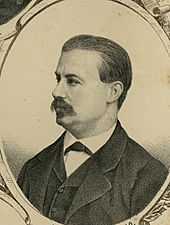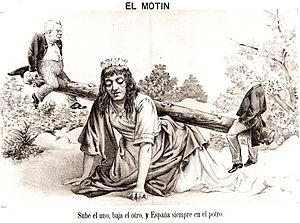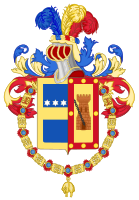Antonio Cánovas del Castillo facts for kids
Quick facts for kids
The Most Excellent
Antonio Cánovas del Castillo
|
|
|---|---|
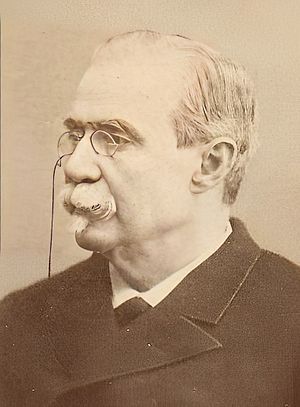 |
|
| Prime Minister of Spain | |
| In office 24 March 1895 – 8 August 1897 |
|
| Monarch | Alfonso XIII |
| Preceded by | Práxedes Mateo Sagasta |
| Succeeded by | Marcelo Azcárraga |
| In office 8 July 1890 – 13 December 1892 |
|
| Monarch | Alfonso XIII |
| Preceded by | Práxedes Mateo Sagasta |
| Succeeded by | Práxedes Mateo Sagasta |
| In office 20 January 1884 – 28 November 1885 |
|
| Monarch | Alfonso XII |
| Preceded by | José Posada Herrera |
| Succeeded by | Práxedes Mateo Sagasta |
| In office 11 December 1879 – 10 February 1881 |
|
| Monarch | Alfonso XII |
| Preceded by | Arsenio Martínez Campos |
| Succeeded by | Práxedes Mateo Sagasta |
| In office 3 December 1875 – 8 March 1879 |
|
| Monarch | Alfonso XII |
| Preceded by | Joaquín Jovellar |
| Succeeded by | Arsenio Martínez Campos |
| In office 10 January 1875 – 12 September 1875 |
|
| Monarch | Alfonso XII |
| Preceded by | Práxedes Mateo Sagasta |
| Succeeded by | Joaquín Jovellar |
| President of the Minister-Regency | |
| In office 31 December 1874 – 10 January 1875 |
|
| President | Himself |
| Preceded by |
|
| Succeeded by |
|
| Seat c of the Real Academia Española | |
| In office 3 November 1867 – 8 August 1897 |
|
| Preceded by | Ángel de Saavedra |
| Succeeded by | Daniel de Cortázar |
| Personal details | |
| Born |
Antonio Cánovas del Castillo
8 February 1828 Málaga, Spain |
| Died | 8 August 1897 (aged 69) Mondragón, Spain |
| Resting place | Pantheon of Illustrious Men |
| Political party | Conservative Party |
| Signature | |
| Nickname | El Monstruo |
Antonio Cánovas del Castillo (born February 8, 1828 – died August 8, 1897) was an important Spanish politician and historian. He is best known for serving six times as the Prime Minister of Spain. He also played a key role in bringing back the Bourbon monarchy to Spain in 1874.
Cánovas was the leader of the Liberal-Conservative Party. His name is often linked with Práxedes Mateo Sagasta. Together, they created a system where their parties would take turns leading the government.
Contents
Early Life and Career
Antonio Cánovas del Castillo was born in Málaga, Spain. After his father died, he moved to Madrid to live with his mother's cousin. He studied law at the University of Madrid. However, he was very interested in politics and Spanish history from a young age.
His political career began in 1854 during a revolution led by General Leopoldo O'Donnell. Cánovas wrote the Manifesto of Manzanares. This document explained the goals of the revolution and helped gain public support.
During the last years of Queen Isabel II's rule, he held several important jobs. He was a diplomat in Rome and governor of Cádiz. He also served as a government minister twice. He was in charge of internal affairs in 1864 and overseas territories from 1865 to 1866.
After the 1868 Glorious Revolution, he left the government. But he strongly supported bringing the Bourbon monarchy back. He led the conservative group in the Cortes (the Spanish parliament). He spoke against universal suffrage (the right for everyone to vote) and freedom of religion. He also helped convince Alfonso XII to issue the Manifesto of Sandhurst, which called for the monarchy's return.
Becoming Prime Minister
Cánovas returned to politics when General Martínez Campos overthrew the First Spanish Republic in 1874. This led to Isabel II's son, Alfonso XII, becoming king. Cánovas then became Prime Minister (Primer presidente del Consejo de Ministros). He held this position for six years starting in 1874.
He was a main writer of the Spanish Constitution of 1876. This constitution officially made Spain a constitutional monarchy. It also limited who could vote, giving more power to the wealthy.
Cánovas del Castillo helped end the last Carlist war in 1876. This war was a threat to the Bourbon monarchy. He also oversaw the victory of Spanish troops in the Third Carlist War. This led to the Basque territory losing its special local laws (called fueros) in 1876. However, negotiations later led to the first Basque Economic Agreement in 1878.
Cánovas created a two-party system with the progressive leader Práxedes Mateo Sagasta. This system was called the turno pacifico (peaceful turn). It meant that the Conservative and Liberal parties would take turns governing. This helped bring stability to Spain. After King Alfonso XII died in 1885, Cánovas also acted as the head of state during the regency of María Cristina.
Political Challenges
By the late 1880s, Cánovas's policies faced problems. First, his approach to overseas territories was not working well. His strict policies against Cuban nationalists were not effective. A major rebellion led by José Martí began in Cuba in 1895. Spain's actions in Cuba also caused growing tension with the United States. This tension eventually led to the Spanish–American War in 1898.
Second, there was growing unhappiness among Spain's working class. People wanted more rights and fairer elections. Cánovas's government used very strict methods to control unrest. These methods included mass arrests and harsh treatment of prisoners. For example, after a bomb was thrown during a religious procession in Barcelona in 1896, many people were arrested. These events caused strong criticism from liberal newspapers across Europe.
Cánovas's efforts helped stabilize Spain's political system for a time. His system allowed rival political groups to work within a constitution. However, it would be many decades before all men could vote and other modern democratic features were fully in place. The system was still largely controlled by powerful local leaders.
A Man of Letters
Cánovas was also a respected writer and historian. His historical writings earned him a good reputation. His book, History of the Decline of Spain (Historia de la decadencia de España), was especially well-known. Because of his writing, he was elected to the Real Academia de la Historia in 1860 at just 32 years old.
He later joined other important academic groups. These included the Real Academia Española in 1867 and the Real Academia de Bellas Artes de San Fernando in 1887. He also led the Athenaeum in Madrid several times.
Assassination
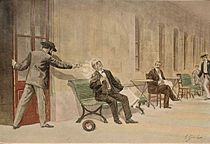
On August 8, 1897, Antonio Cánovas del Castillo was shot and killed. He was at a spa called Santa Águeda in Mondragón, Spain. His assassin was Michele Angiolillo, an Italian anarchist. Angiolillo said he acted to avenge the execution of Jose Rizal and other anarchists in Barcelona. Cánovas died before Spain lost its last colonies to the United States in the Spanish–American War.
Personal Life
Cánovas married María de la Concepción Espinosa de los Monteros y Rodrigo de Villamayor in 1860. She passed away in 1863. He later married Joaquina de Osma y Zavala in 1887. He did not have any children who survived him.
His Political Ideas
Cánovas was the main person behind the Restoration period in Spain. He wanted to bring stability to Spanish society. His political ideas were influenced by thinkers like Edmund Burke. Cánovas believed in a strong sense of national identity. He was also against universal suffrage, believing it would lead to socialism.
Because of his important political and intellectual role, his peers sometimes called him el Monstruo ("The Monster").
Legacy
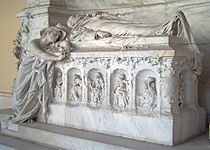
Cánovas's strict policies and political methods had a lasting impact. They helped fuel nationalist movements in Catalonia and the Basque provinces. They also set the stage for worker unrest in the early 20th century.
Spain's disastrous colonial policy led to the loss of its remaining colonies. It also weakened the government at home. A failed military coup after the war led to a long period of political instability. This eventually caused the monarchy to collapse and the constitution Cánovas wrote to be dissolved.
His white marble tomb was carved by Agustí Querol Subirats. It is located in the Panteón de Hombres Ilustres (Pantheon of Illustrious Men) in Madrid.
Arms
See also
 In Spanish: Antonio Cánovas del Castillo para niños
In Spanish: Antonio Cánovas del Castillo para niños


